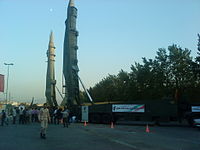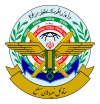|
Sejjil
Sejil, or Sejjil, (Persian: سجیل) is a family of Iranian solid-fueled medium range ballistic missiles. The Sejil are replacements for the Shahab liquid-fueled ballistic missiles. According to US Pentagon sources, the missile profile of the Sejil closely matches those of the Ashura, Ghadr-110 and the Samen.[5] DesignAccording to Jane's Information Group, details of the design other than the number of stages and that it uses solid fuel have not been released. Uzi Rubin, former director of Israel's Ballistic Missile Defense Organization, indicated that, "Unlike other Iranian missiles, the Sajil bears no resemblance to any North Korean, Russian, Chinese or Pakistani (missile technology). It demonstrates a significant leap in Iran's missile capabilities." Rubin went on to state that the Sejil-1 " ... places Iran in the realm of multiple-stage missiles, which means that they are on the way to having intercontinental ballistic missile (ICBM) capabilities ..."[6] The missile utilizes composite solid fuel and unlike the Shahab-3 medium-range ballistic missile (MRBM), which is launched only vertically, the Sejil could be launched at a variable angle.[7] As a weapon, Sejil presents much more challenge to Iran's potential enemies, as solid-fuel missiles can be launched with much less notice than liquid-fueled missiles, making them more difficult to strike prior to launch.[8] Iran claims that if launched from the city of Natanz, it could reach Tel Aviv in less than seven minutes.[9] Variants
See also
External linksReferences
|
||||||||||||||||||||||||||||||||||||



